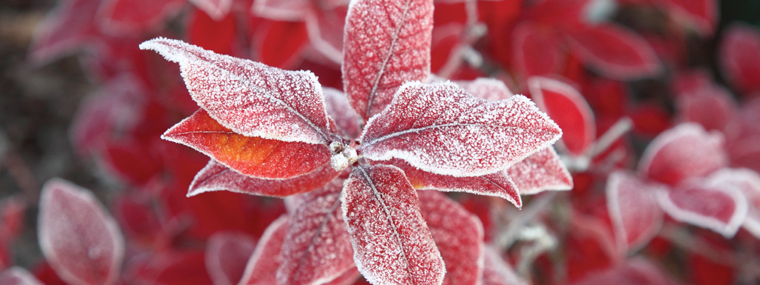
Cold Weather Plant Care
By Lynn Barber / Published February 2016

At some point, the temperatures in our tropical paradise will become more winter-like. Planning ahead may well save all of us both time and money. We should consider the potential consequences of cold weather and how we can protect our landscape plants.
Plant coverings are frost protection versus cold protection. This means that plant coverings can decrease some frost damage but not necessarily cold damage. We can use plant coverings, such as sheets, quilts, or frost/freeze cloth. The coverings should be in place before the sun goes down on the evenings where frost or cold weather is predicted. Except for frost/freeze cloth, the covers must be removed during daylight. Sheets and quilts do not allow air and light to flow through. Frost/freeze cloth may remain in place for several days because air and light can move through the cloth. Plastic is not a good choice because it transfers the cold onto the plant. You can, however, put plastic on top of a sheet or quilt during windy freezes or on very cold nights. The covering you select must extend to the ground to capture heat from the soil and provide wind protection. You can make a frame over the plant you are covering; then place the covering on top of the frame. This way, nothing touches the plant itself. A cardboard box large enough to fully cover the plant is another option.
Even though you have covered your plants, an additional source of heat may be needed. Some people use Christmas tree lights—not LED lights because they do not provide heat—or a light bulb may provide enough heat to protect your plant from freezing. You do not want the light bulb to touch the sheets/quilts or the plant itself. Covering tropical plants in your landscape and those not hardy in your zone may help those plants survive cold weather. If you can’t live without tropical plants and they have not survived the past few winters, you may need to plant them in containers, so you can move them from your landscape to your porch or lanai. Your garage may well be 10-plus degrees warmer than the outside temperature, which is another option for plant storage during freezing temperatures. Container plants can be covered to the ground or grouped together and covered to save you time and the number of sheets and quilts you may need to utilize.
Don’t encourage new plant growth by pruning or fertilizing because the plant will be more prone to cold damage. Pruning alters the hormone balance resulting in a growth flush. There are two options on pruning. The first is to delay pruning post-freeze until you see new growth and after the risk of a future freeze passes. Then prune beyond the point of black or brown stem coloration. The damaged plant material insulates and protects the live parts of the plant. The second option is to prune all dead plant material and freeze damage after the freeze. This makes it easier to cover and protect the plant if a freeze occurs before spring. However, any new growth that results from this pruning will be damaged by the next freeze/frost or potentially cold weather, thus doubling your pruning work.
Lynn Barber, Agent
University of Florida/IFAS Extension, Hillsborough County
Lynn Barber, Agent, University of Florida/IFAS Extension, Hillsborough County, is responsible for educating residents on the nine principles of the Florida Friendly Landscaping™ program. These principles include right plant right place, water efficiently, fertilize appropriately, mulch, attract wildlife, manage yard pests responsibly, recycle, reduce stormwater runoff, and protect the waterfront. Barber is past president of the Florida Association of Natural Resource Extension Professionals and has received numerous awards for programming, publications, and television and radio segments. As a Master Gardener, she has given back thousands of hours in environmental horticulture education to the community.
Healthy plants are less prone to cold damage and more resistant to insect damage or disease than are unhealthy plants. Before the freeze or near-freeze, slightly moisten the soil because moist soil releases more heat than dry soil. You should hand water the ground beneath the plant in the root zone area you will be covering, which will help. Maintaining a two to three inch layer of mulch after it settles will also help your plants because it regulates the soil temperature and protects the plant roots. After a freeze has occurred, you should check to determine if your plant needs water. The leaves could be losing water while frozen water remains in the soil. Applying water to the soil will provide a thaw and water your plant at the same time.
Practice the first principle of Florida-Friendly Landscaping™, which is right plant, right place. Consider sun/shade, wet/dry, mature size, soil type, and pH. Cold-sensitive ornamentals should be planted in an area where air flows freely. Use screening, fences, and landscape design where multiple plants are located strategically for protection. Well-drained soil enhances root growth and stability. Plants in the shade remain dormant and stay dormant until later in the spring. You can reduce the cold injury the plant will suffer if you plant it under a tree canopy because the evening temperature is higher. Shade-thriving plants have less moisture loss than full sun-loving plants. Sun-loving plants living in shady conditions are less cold tolerant.
Most perennials are root hardy. While the foliage will die back to the ground, new growth will appear in the spring. Be patient because it can take several months before shoots are visible above the ground. More than once, I have dug up a plant in the spring after giving up on its ability to survive only to find shoots underground and healthy roots. Then, I had the opportunity to replant it in the same spot! Not a time saving maneuver!
As always, follow the landscape or architectural control procedures in your deed restrictions before making changes. For more information about the nine principles of the Florida-Friendly Landscaping™ Program or for assistance with gardening-related questions, contact your local University of Florida Extension office and visit the University of Florida website solutionsforyourlife.com.


